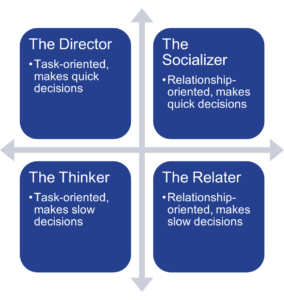Developing Communication Competency: Verbal and Non-Verbal Communication

Because communication – the act of a sender conveying information to a receiver in a method that delivers the meaning the sender intended – is an essential element of business, it is an important component of business analysis. In fact, it’s so essential that it has been codified as one of the underlying competencies in the Guide to the Business Analysis Body of Knowledge. But communication isn’t useful solely for business analysts. Solid communication techniques underscore business best practices across sectors and specialties. Effective communication benefits all stakeholders regardless of your sector, industry, or enterprise.
In this blog post and the next, we’ll delve into how to inform and enhance verbal, non-verbal, and written communication and listening skills in the workplace.
Communication Styles and Tones
 Everyone thinks and communicates in a unique way. There are four principal communication styles based on your decision-making speeds and focus. Decision-making speeds range from slow to quick, and orientation or focus ranges from task-based to relationship-centric. The four styles are the director, the socializer, the thinker, and the relater.
Everyone thinks and communicates in a unique way. There are four principal communication styles based on your decision-making speeds and focus. Decision-making speeds range from slow to quick, and orientation or focus ranges from task-based to relationship-centric. The four styles are the director, the socializer, the thinker, and the relater.
Of course, each style of communication has benefits and drawbacks. Quick decision-makers, such as the Director and the Socializer, might help drive rapid progress but may also miss critical information that would better inform their decisions. Slow decision-makers, including Thinkers and Relaters, might be better informed but miss a window of opportunity. Relationship-oriented communicators (Socializers and Relaters) might gain key insights from their interactions with constituents but may not accomplish important tasks. Task-oriented communicators (Directors and Thinkers) might lose out on critical information or constituent-building opportunities but will move through action items effectively.
Effective verbal communication skills include the ability to make your meaning understood. Partner verbal communication with active listening to ensure your receiver understands the information presented. Understanding the tone of the communication and how it can positively or negatively influence the listener allows you to communicate more effectively. It can help those in other positions, as well. Your communication style and tone aren’t set in stone – on-the-ground conditions might require you to alter either.
To succeed in business, we must all develop an underlying verbal and nonverbal communication competency. What does competency look like? Read on.
Verbal Communication Competency
Any communication aims to convey ideas, concepts, facts, and opinions to various stakeholders. Verbal communication uses spoken words to convey information from the sender to the receiver. While it can – and usually should – be paired with both written and non-verbal communication, verbal communication depends specifically on the sender’s choice of words and the tone of voice to ensure effective and efficient transfer of information.
How do you know when you are competent in verbal communication? Successful communicators know how and when to restate their message, ensuring everyone understands the information clearly. They also remain calm and rational when delivering their message. Successful communicators are also genuine and confident. Finally, they also know their communication goals – what they are trying to communicate and what they want from their receiver.
For ultimate efficacy, verbal communication must rely on emotional and non-verbal cues.
Non-Verbal Communication Competency
When the receiver can see the sender, the sender’s nonverbal communication impacts the meaning of the message being understood by the receiver. When the sender can see the receiver, the receiver can respond. The sender and receiver are engaged in a dialogue, even though the receiver may not speak verbally. Monitoring the receiver’s nonverbal communication allows the sender to consider adapting the message for the receiver.
So, the purpose of non-verbal communication is to send and receive messages through body movement, posture, facial expressions, gestures, eye contact, and other non-verbal cues. Nonverbal communication conveys much more meaning than words alone. Moods, attitudes, and feelings impact body movement and facial expressions. Non-verbal communication begins immediately when one person can see another.
Effective non-verbal communication skills present a trustworthy, confident, and capable demeanor. Being aware of nonverbal communication provides the opportunity to be aware and address the feelings of others that are not expressed verbally. But, how do you strengthen and develop your non-verbal communication competency?
Non-verbal communicators are aware of body language – both their own and their audience’s. They understand that body language offers clues and can confirm their understanding during the dialogue. They will address and resolve those inconsistencies if the non-verbal and verbal communication does not match. Strong non-verbal communicators are also intuitively aware of their body language and will incorporate that into the exchange.
Demonstrating Superior Communication Skills in BA Work
To communicate effectively, we must speak into the listening of others. In other words, we must be able to speak so that people will hear us. We must adapt our communication to match the styles of our audience. When communicating to a group, it’s important to incorporate as many competencies as possible, including both verbal and nonverbal. When you do, you are more likely to be heard by the audience. Superior communication skills also include understanding and adapting your communication style to suit the needs of your industry, organization, and audience.
At Momentum, our consultants are trained in communication and can guide our clients to apply them to their work. Our next post will explore how written and listening skills further promote superior communication.
This post was adapted from a Momentum presentation. To learn more about developing communication competency, contact us.
 Tap to email
Tap to email
